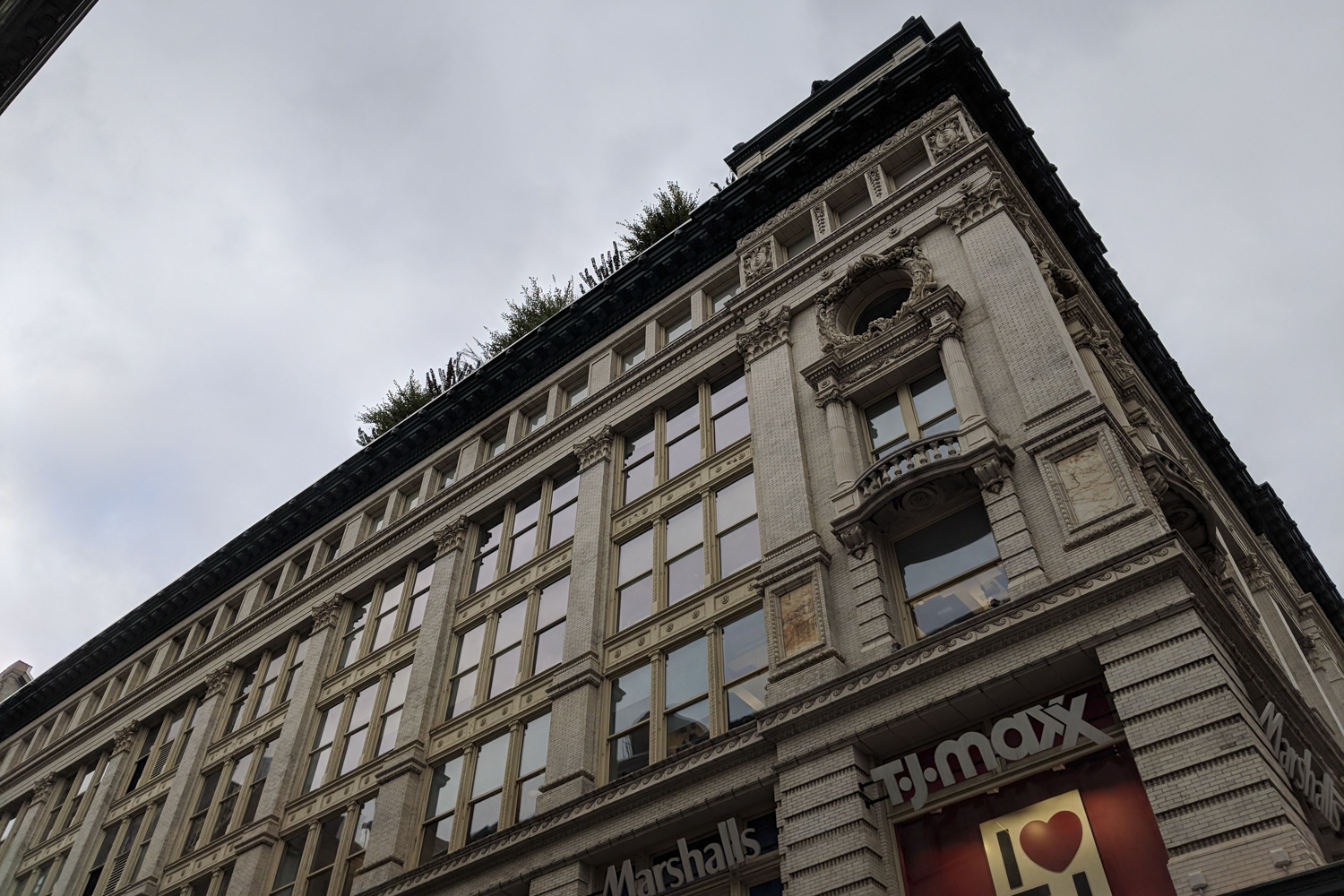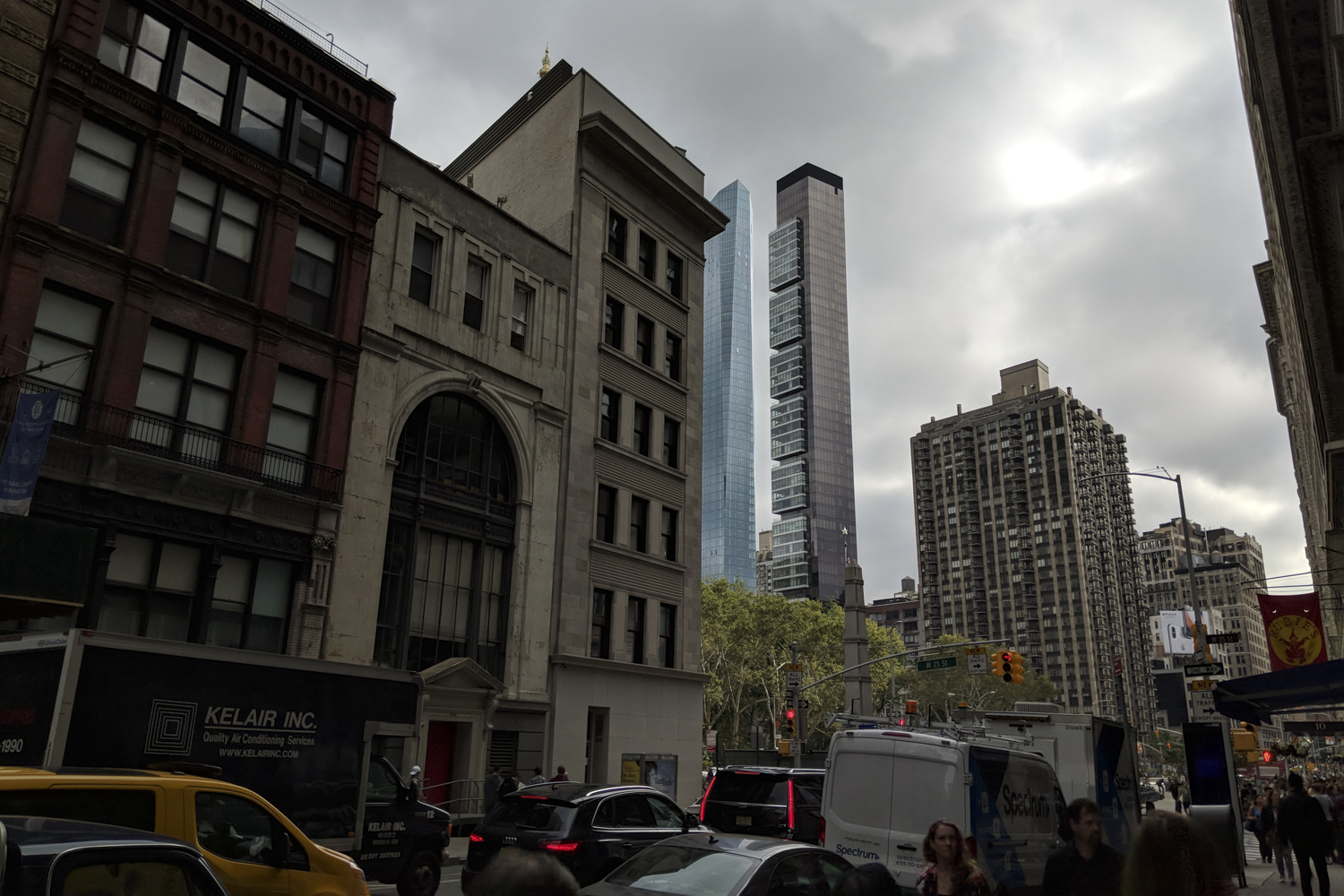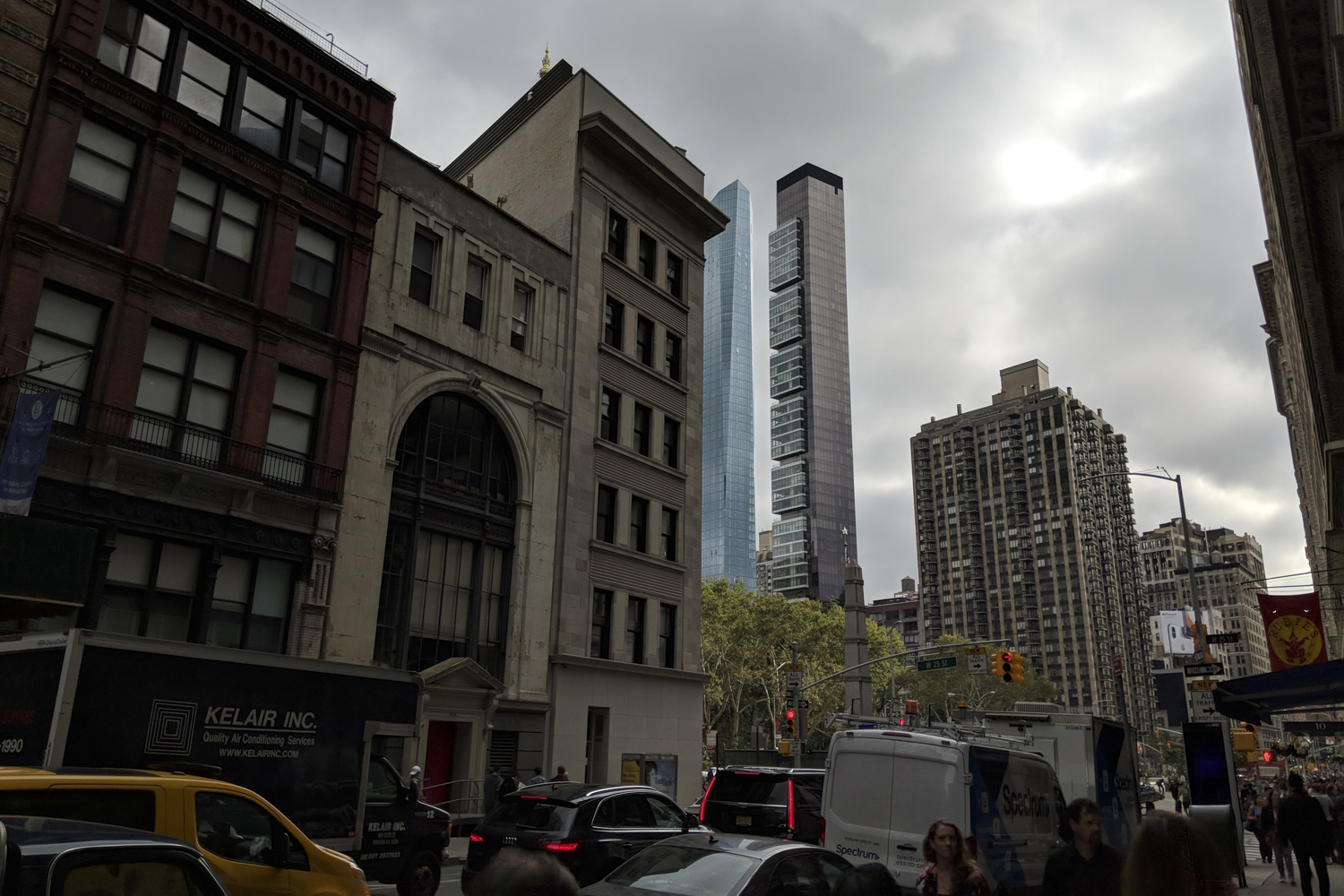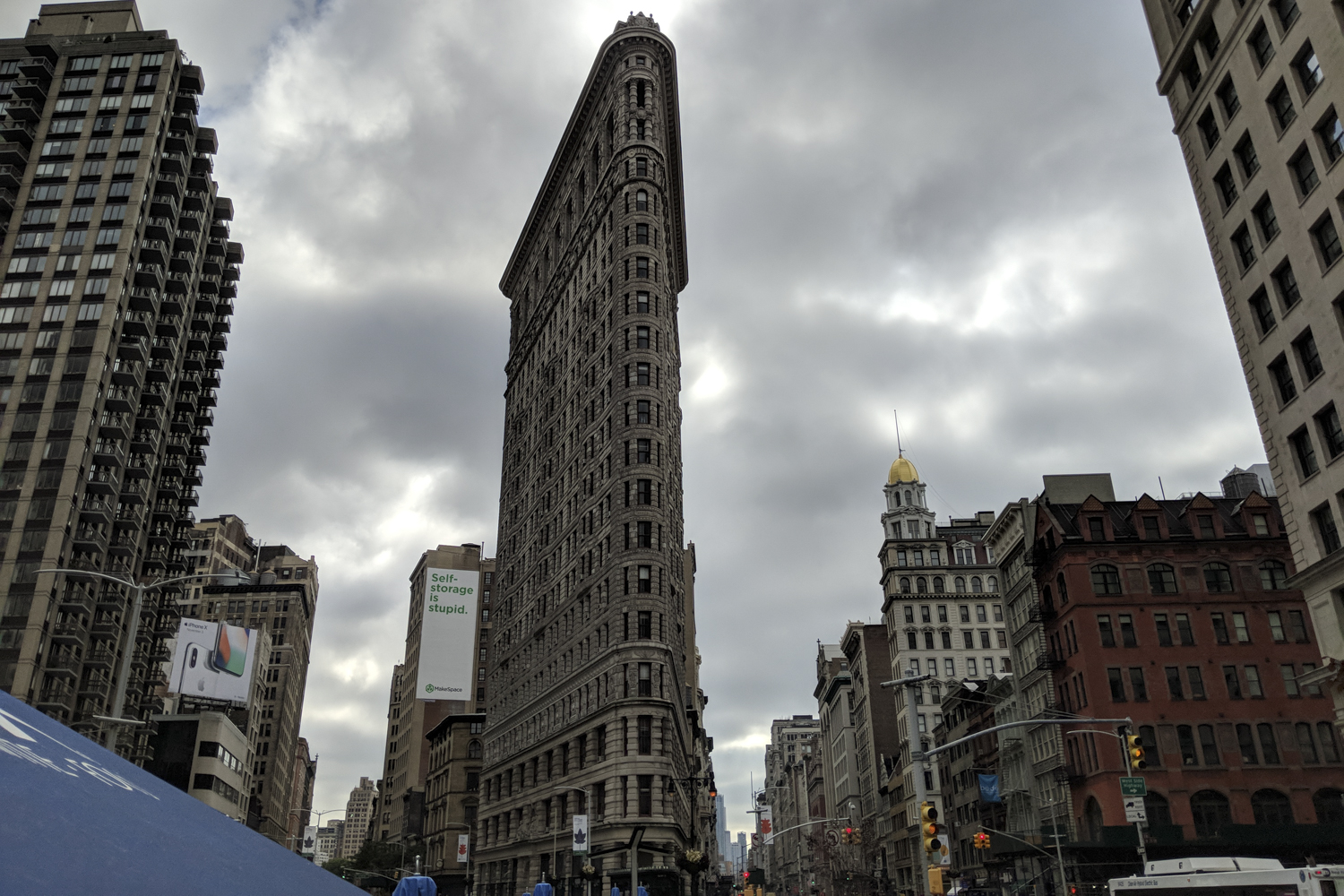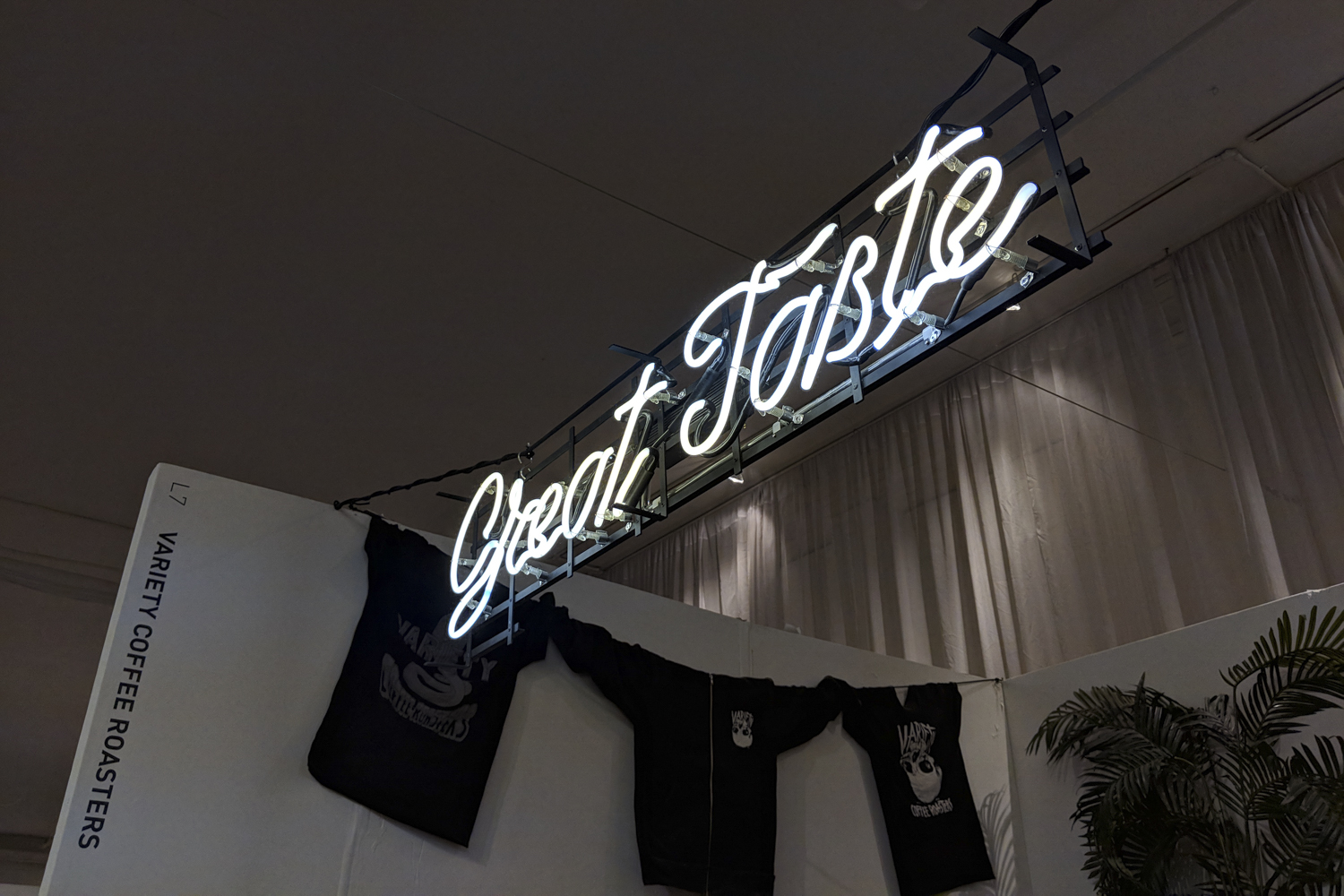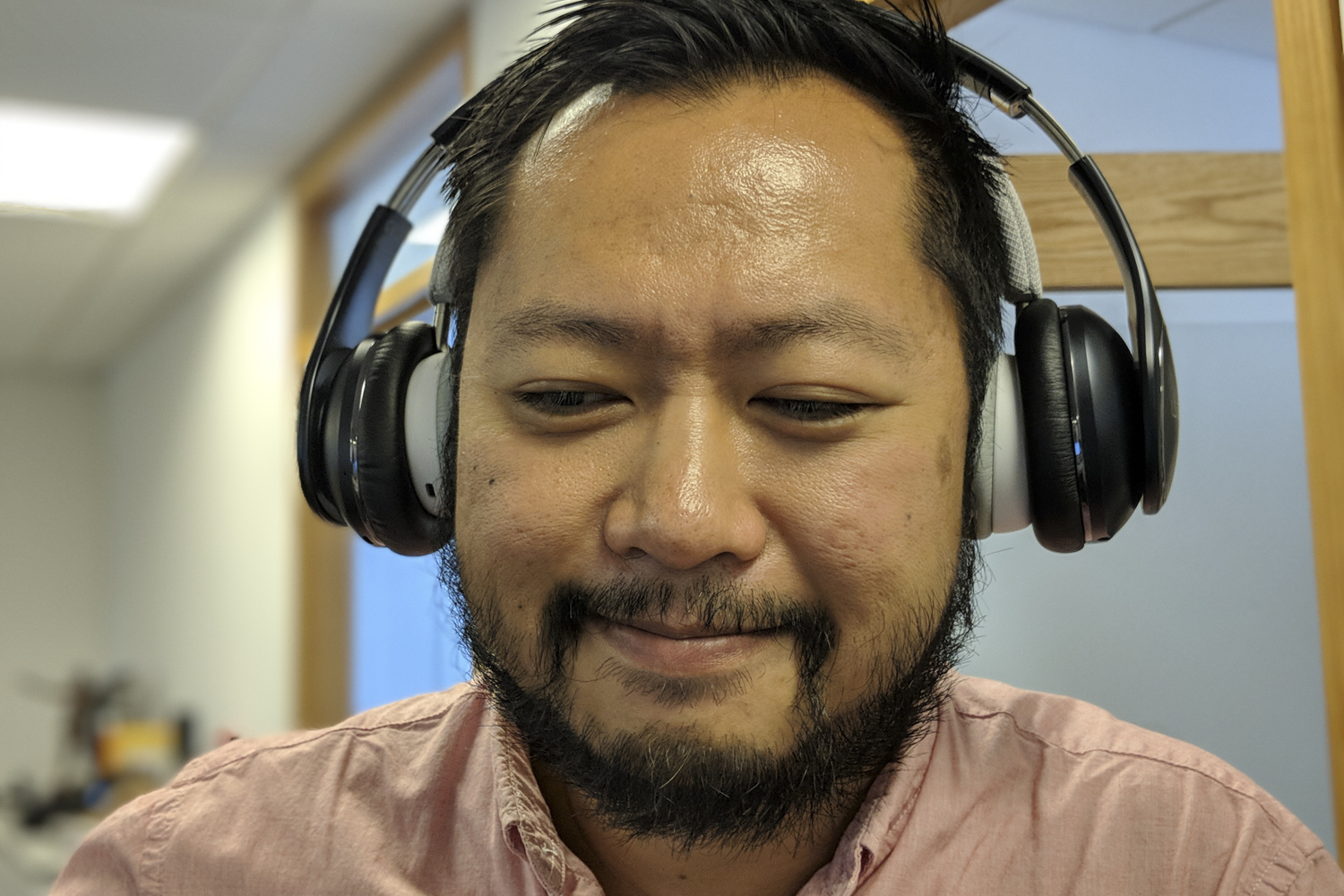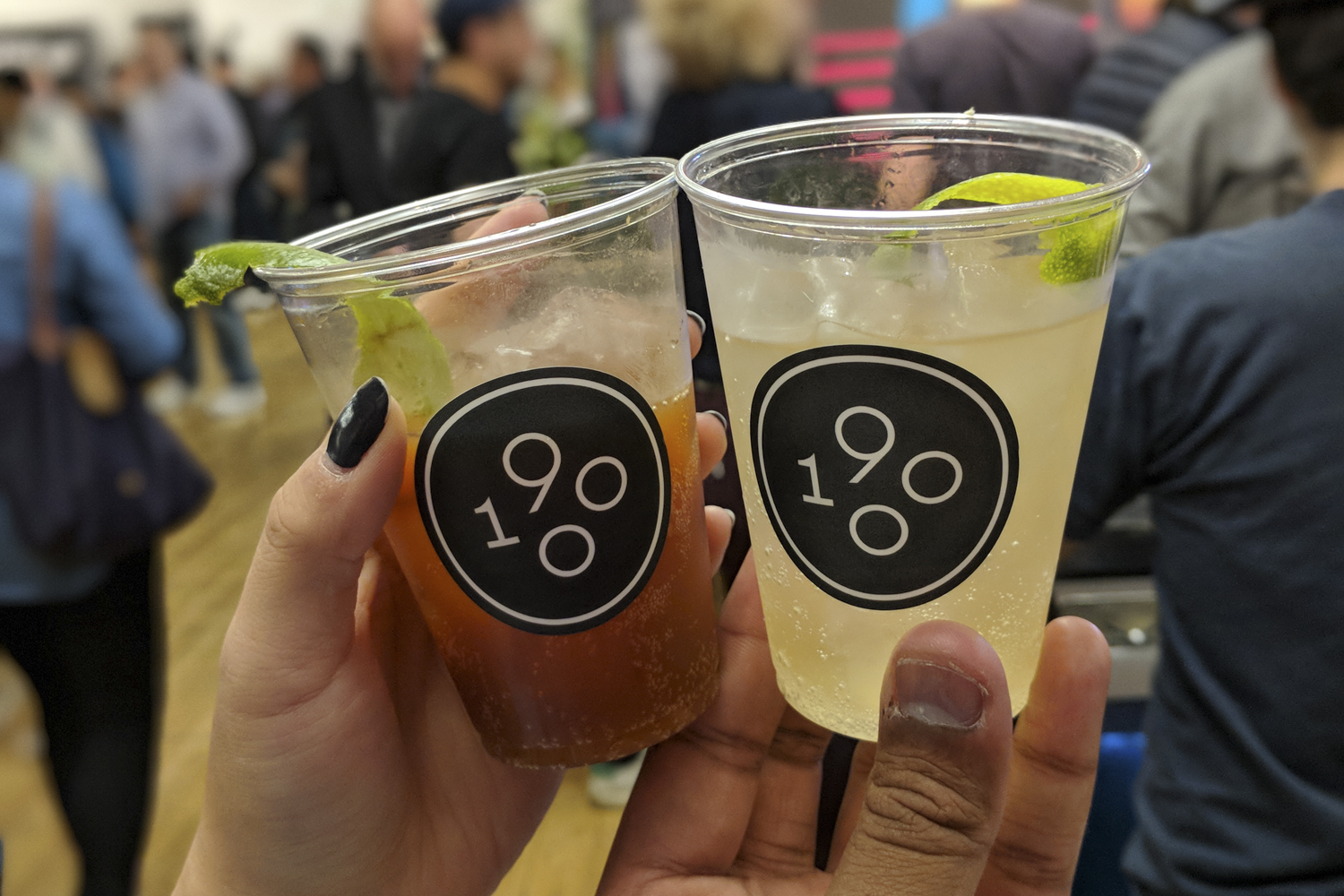- Blazing fast speed
- Great software experience, fast updates
- Excellent camera
- IP67 water-resistant
- Compact, colorful screen
- No headphone jack
- Average battery life
- Chunky edges around screen, dated design
The differences between last year’s Google Pixel and Pixel XL smartphones revolved around size — the bigger XL model was able to pack a bigger battery, and the larger screen could accommodate a higher resolution. While Google proudly said you get the same features again in the new Pixel 2 and Pixel 2 XL, it’s wrong. Design is very much a feature, and the new Pixels diverge significantly on it. Don’t get us wrong — we crowned the Pixel 2 XL as the best Android phone, and the Pixel 2 shares many of the same merits. In our review, we found that while you get a lot of the same functionality with the Pixel 2, there’s far less style.
Bezel-more, compact
In a sea of growing “bezel-less” flagship phones, it’s easy to be puzzled when looking at the Pixel 2. It has nearly the same-size edges around the screen as the original Pixel, making the 5-inch display size look small. But the biggest takeaway is how the phone looks dated. Showing it to coworkers, friends, even strangers, they nearly all ignored the Pixel 2 in favor of the Pixel 2 XL, which is bezel-less.
It’s surprising how quickly edge-to-edge designs have made people think phones with bezels look old. Plenty of great new phones haven’t adopt the new design trend, like the HTC U11 and the OnePlus 5, and even Apple’s iPhone 8 and 8 Plus — though Apple has an upcoming excuse called the iPhone X. Google joined the trend with its Pixel 2 XL, but small phone lovers are stuck with a more dated design on the ordinary Pixel 2.
As cool as cutting bezels looks, it also offers tangible benefits. The 5.8-inch iPhone X’s dimensions are just a tad bigger than the 4.7-inch iPhone 8, but you get a display bigger than the 5.5-inch iPhone 8 Plus. With the Pixel, you’re either stuck with a small phone and a small screen, or a big phone and a big screen.
All that said, we still love the compact size of this phone; nothing on the screen ever feels out of reach. The 5-inch screen has a 1,920 x 1,080-pixel resolution, and unlike the Pixel 2 XL’s POLED panel, the Pixel 2 uses an AMOLED display.
You won’t find the display issues people have been reporting on the Pixel 2 XL. The screen gets bright enough to read in broad daylight, but it’s not as bright as its bigger brother. Colors and blacks are a little brighter on the Pixel 2, but the screen’s white balance is a tad warmer than the Pixel 2 XL. It’s still a splendid screen with great viewing angles.
Still, after some feedback the Pixel 2 and the Pixel 2 XL will be getting a software update that adds a Saturation Mode, in case you want more vibrant colors. The update will also attempt to mitigate any sign of screen burn in, even though the device hasn’t shown any signs of it yet. You can read more in-depth about it here.
We love the compact size of the phone; nothing on the screen ever felt out of reach.
The rear design has the same two-tone mix of glass and metal found on the Pixel 2 XL. The aluminum coating has a matte, chalkboard-like finish that feels comfortable in the hand, and doesn’t attract any fingerprints. You’ll find the fingerprint sensor below the glass near the center, with the camera jutting out slightly on the top left. The glass at the top isn’t just for looks: It houses the antennas, which is why you won’t find ugly antenna bands anywhere.
The power button is on the right edge above the volume rocker. Sadly, there’s no headphone jack, and the only other port is the USB Type-C on the bottom.
We like the rear design, but you’re buying the Pixel 2 for its 5-inch size (and smaller price tag). If you don’t care about the shrinking bezel trend, you’ll be happy with a colorful and bright AMOLED display, and a compact phone you can easily wrap your fingers around.
Stereo front-facing speakers, no headphone jack
There is a silver-lining with the Pixel 2. Unlike last year’s phone, Google gave a purpose to the chunky edges: Dual front-facing speakers. We complained that it was easy to block the bottom-firing speaker last year just by holding the phone in a certain orientation. That’s not the case anymore. The Pixel 2 sounds great, and gets really loud. Music sounds well-balanced and never tinny.
If you’re lamenting the loss of the headphone jack, there are still plenty of great smartphones out there with the 3.5mm port. If you don’t mind it, you should know the phone supports the latest Bluetooth 5 standard, and a USB Type-C to 3.5mm headphone jack adapter is included in the box.
Fast and fluid performance
The Pixel 2 follows its predecessor with unhinged performance thanks to the Qualcomm Snapdragon 835 processor inside, with 4GB of RAM. With Google designing the hardware and software, the Pixel phones offer much tighter integration between the two, similar to Apple’s work with iOS and the iPhone.
We saw absolutely zero issues after using the device for more than two weeks. Performance was fluid and fast, with apps launching quickly, smooth scrolling in apps and webpages, and games running without a hitch. We had no trouble playing Transformers: Forged to Fight, a graphically-intense fighting game, and Tiny Archers didn’t put up a struggle.
The benchmark scores don’t suggest the Pixel 2 as the fastest device around, oddly. We saw higher scores on other Android phones such as the LG V30 and the Galaxy Note 8, with the iPhone 8 Plus still reigning king.
- AnTuTu: 146,876
- Geekbench 4 CPU: 1,885 single core, 5,861 multicore
- 3DMark Sling Shot: 2,902
Still, the Pixel 2 beat out the Pixel 2 XL’s score — likely due to the processor needing to power a smaller, lower-resolution screen. Despite these overall lower scores, you won’t be disappointed with this phone’s performance. It’s just as good a performer as the other Android flagship phones, if not better.
With the Pixel 2, you get the option of 64GB or 128GB of storage. There’s no MicroSD card slot, but Google offers unlimited, free high-quality Google Photos storage.
A simple but useful Android 8.0 Oreo interface
From the start up process to the Settings menu, the Pixel 2’s software is clean, simple, and uncluttered. It runs Android 8.0 Oreo, the latest flavor of Google’s mobile operating system. But what’s truly unique about the Pixel series is how you’ll always get version and security updates as soon as they are released. Even if other phones run stock Android, like the Essential Phone, you won’t always get the next version of Android as fast as a Pixel phone.
From the start up process to the Settings menu, the Pixel 2’s software is clean, simple, and uncluttered.
Android 8.0 Oreo is a relatively minor update that introduces a few handy new features such as Notification Dots, like Apple’s unread badges on app icons, and Picture-in-Picture mode, which lets you continue watching a video while in another app. If you want to learn more about what’s new in Oreo, check out our in-depth guide.
Swipe down for the Oreo redesigned notification drawer, swipe up for apps, and swipe to the right to access the well-designed Google feed. You can also press and hold the home screen to add widgets, double tap the screen to wake the phone, and slide your finger up and down the fingerprint sensor to open or close the notification drawer. These are all fairly standard Android functions, so what’s unique on the Pixel 2?
First and foremost, the At A Glance widget at the top of the screen is new — it shows you the date and weather, but if you have a calendar event coming up, it will display it right there. The Google search bar is now below the dock, for easier access. We’re enjoying this placement a lot more than its traditional placement up top, because it makes it easy to tap one handed.
Press and hold the power button, and you’ll see the Power Off and Restart interface looks nicer, similar to the layout of App Shortcuts when you press and hold an app. The Settings menu has been simplified and condensed. If you’re having trouble finding something, the search bar comes in handy.
There aren’t many changes to Google Assistant’s interface. Press and hold the home button and the artificially intelligent robot will pop up for you to ask it search queries, set reminders, send texts, open apps, and more. What’s new is Active Edge, which lets you squeeze the sides of the phone to summon Google Assistant. It’s almost the same exact feature as HTC’s Edge Sense on the HTC U11. It’s handy if you can’t unlock your phone and press the home button, or if you don’t want to say “OK Google” in public. We wish you could use it to customize what you want to open, in case you don’t use Google Assistant, but sadly Google’s a bit restrictive here.
One of our favorite additions is Now Playing. It’s not a feature you use, as it works in the background. Now Playing detects what song is playing wherever you are, and when it identifies it, the name of the song and artist fades into the always-on display. Google said it works offline with a database of popular songs that’s being updated every week, and nothing is ever shared with Google.
It doesn’t always detect the song, especially with songs that aren’t well-known, but it’s nice to see it casually pop up when at a coffee shop or restaurant. Tap on the song name and Assistant will open it, allowing you to check it out in your music app. If you actively want to search for a song, you’re better off using the faster method: Ask Assistant “what’s this song,” and it will identify it. If you don’t care for this feature, or you think it’s taking up too much battery, you can always turn it off in the Settings menu.
The software experience on the Pixel 2 is a joy to use; the interface is fluid, and everything just works.
The best camera on a smartphone
Google’s first Pixel phone quickly became regarded as one of the best smartphone cameras last year. It has hit a home run again with its second generation, even if Google didn’t jump on the dual-camera bandwagon.
We like that Google lets you choose a smaller phone without settling for a lesser camera. The Pixel 2 has the same camera as the Pixel 2 XL. The rear 12-megapixel has a f/1.8 aperture, and it’s fast. The camera app opens quickly, there’s virtually no shutter lag, and while it takes a second or two to process the image, the result is usually stunning. You’ll find rich details, and far more accurate color accuracy than last year’s Pixels, which tended to oversaturate photos.
Best of all, this all rings true in nearly all lighting conditions. The included optical image stabilization makes the phone capable of taking great low-light photographs, with incredibly reduced noise.
Google’s Pixel 2 camera leaves the HDR+ mode always on. This mode helps with scenarios where there’s a bright background and a dark foreground, or vice versa. You’ll end up getting a well-exposed photo, where nothing is specifically too bright or too dark. One thing we did find frustrating is how the autofocus never locked onto a subject we tapped on. Move the phone a little and it would change the exposure of the whole photograph.
What used to be “Lens Blur” on the Pixel is now Portrait Mode on the Pixel 2. The function lets you add blur behind a subject, creating a DSLR-like photo. It’s not just a name-change, though. You used to have to tap the shutter icon and raise the phone up over the subject a little so it could gather depth data. Now it’s all done via software, and it’s far simpler to use. Just place a subject in front of you, tap to focus, and click the shutter icon.
The Pixel 2 has the same camera as the Pixel 2 XL.
It’s impressive what the Pixel 2 can do with just software. It accurately identifies the edges around a subject — including hair — and adds the blur accordingly. The blur, or bokeh, isn’t as strong as the iPhone 8 Plus, but it can still make the photo look great. It’s not perfect, though. There have been several times when the Pixel 2 inaccurately determined depth and placed the bokeh too much in one place or too little.
But what’s more eyebrow raising is how good Portrait Mode is with the selfie camera. Since it’s all software, Google doesn’t need any specific hardware to be able to capture selfies with this blur-style effect. The results are just as impressive as the rear camera. The image quality looks great and so is the accurate outline of the subject around the blur. If you’re an avid selfie taker, this might be the camera for you.
There’s also two new camera-specific features that are a little more gimmicky. You’ll soon get the option for Augmented Reality Stickers directly in the camera app. You’ll be able to place stickers in your photos and have them interact with other stickers or yourself. The first sticker pack will be filled with characters from Netflix’s “Stranger Things.”
The second somewhat gimmicky feature is Google Lens. Snap a picture, then tap on the lens picture in Google Photos and the Assistant will attempt to identify it. It’s still in beta, and it can only identify landmarks, books, artworks, movie posters, album covers, and video game covers. One of our favorite ways to use it, though, is to have it quickly grab content from a business card. It will detect email addresses and phone numbers, and will ask if you want to send an email, place a call, or add both to a new or existing contact. Google said Lens will continue to evolve, so expect it to get better over time.
We’ve been more than satisfied with our Pixel 2’s camera, and we’ve often found ourselves audibly saying “wow” when looking at some of its results.
Battery life isn’t up to par
It’s not all great for the Pixel 2. Like its bigger brother, you won’t get the best battery life on this smartphone. With moderate to heavy use, we consistently returned home with around 20 percent by 7 p.m. That’s with streaming music, browsing social media and the web, playing videos, taking pictures and video, and more. We would occasionally top up the charge a little during the day, just to make sure it would get through the day. The battery gave us anxiety enough to make sure we had a charger or battery pack with us at all times.
If you’re more of a light user, you’ll be happy with the 2,700mAh battery capacity. We were able to hit 42 percent by 8 p.m. after taking it off the charger at 8 a.m. Leaving the phone in standby also doesn’t drain too much battery: Our Pixel 2 lost 5 percent after leaving it alone from 12 p.m. to 9 p.m.
The benefit of carrying the included charger means you can utilize Google’s fast-charging. We saw the phone earning back 50 percent of its charge from 15 percent in about 45 minutes.
Price, availability, and warranty
The Google Pixel 2 will set you back $650 from the Google Store, Verizon, and Best Buy. Some colors are out of stock. Verizon’s ads claim the Pixel 2 is “only on Verizon,” but it’s just the only carrier selling the phone. If you buy the phone through Google, it comes unlocked and can work with any major U.S. carrier.
If you don’t want to pay the whole price upfront, Google, Verizon, and Best Buy offer a monthly payment plan. For example, you can pay $27.04 a month for 24 months for Google’s plan, without interest.
Google originally offered a standard limited one year warranty, but the company has now extended it to two years after qualms about the Pixel 2 XL’s screen. Your phone is now protected from manufacturing defects two years from the date of purchase. For added protection, you can tack on Preferred Care for $130 extra and it offers “worry-free protection for your phone for two years,” including two claims for accidental damage. That also includes priority access to specially-trained agents 24/7, access to walk-in centers for screen repairs, and unlimited expert sessions to help you learn to use the phone better.
Our Take
If the chunky bezels and the lack of a headphone jack don’t put you off, the Pixel 2 is a brilliantly fast smartphone with a stunning camera.
Is there a better alternative?
Yes. If you want a compact phone that offers similar performance and looks gorgeous, take a look at the Essential Phone, which just got a $200 price cut. At $500, it’s the best looking phone with the same Qualcomm Snapdragon 835 processor and stock Android. You most likely will not like its camera, which has some issues.
If the Galaxy Note 8 is too big, take a look at the Samsung Galaxy S8. It also offers similar performance, can be found for less than $600, and has a great camera. If you’re not feeling Android, the iPhone 8 is a great alternative, though the iPhone X is coming out soon.
How long will it last?
The Pixel 2 will likely last you four to five years, maybe more. Google is promising updates for three years after its release.
You may want to put a case on it to protect the front and rear glass, but at least you won’t have a problem with water — the Pixel 2 is IP67 water-resistant, meaning you can take it underwater up to 1.5 meters for 30 minutes.
Should you buy it?
Absolutely. As we mentioned before, the two main deal breakers are likely the lack of a headphone jack and the dated front design. If you don’t care about that, you won’t be disappointed with what the Pixel 2 has to offer.















